Click on images to enlarge
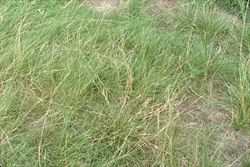
infestation (Photo: Sheldon Navie)

infestation (Photo: Sheldon Navie)

habit in flower in summer (Photo: Sheldon Navie)

habit in autumn (Photo: Sheldon Navie)
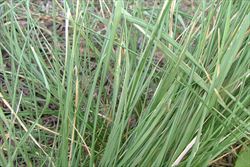
leaves (Photo: Sheldon Navie)

young seed-head (Photo: Sheldon Navie)
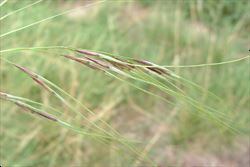
close-up of flower spikelets (Photo: Sheldon Navie)
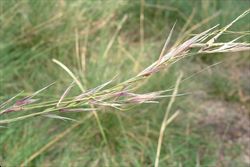
immature seed-head with seeds (Photo: Sheldon Navie)
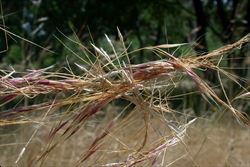
mature seed-heads with seeds (Photo: Rob and Fiona Richardson)

close-up of purplish-coloured bracts and young seeds (Photo: Sheldon Navie)

close-up of mature seed sowing collar-like corona (Photo: Rob and Fiona Richardson)

close-up of 'stem seeds' in the leaf sheath (Photo: Sheldon Navie)
Scientific Name
Nassella neesiana (Trin. & Rupr.) Barkworth
Synonyms
Stipa neesiana Trin. & Rupr.
Family
Gramineae (South Australia)Poaceae (Queensland, New South Wales, the ACT, Victoria, Tasmania, Western Australia and the Northern Territory)
Common Names
Chilean needle grass, Chilean needlegrass, Chilean speargrass, spear grass, Uruguayan tussockgrass
Origin
Native to South America (i.e. Bolivia, Ecuador, Peru, southern Brazil, Argentina, Paraguay, Uruguay and Chile).
Naturalised Distribution
Widely naturalised in south eastern Australia (i.e. in eastern and southern New South Wales, in the ACT, in many parts of Victoria, in Tasmania and in south-eastern South Australia). Also recently recorded from a few locations in sub-coastal south-eastern Queensland.
Also naturalised overseas in Europe (i.e. in the UK and southern France) and New Zealand.
Habitat
A weed of pastures, grasslands, open woodlands, parks, roadsides, disturbed sites, waste areas and creekbanks in temperate, semi-arid and sometimes also drier sub-tropical regions.
Habit
A tussock-forming, long-lived (i.e. perennial), grass with upright (i.e. erect) or arching flowering stems (i.e. culms) usually growing 30-120 cm tall.
Distinguishing Features
- a densely tufted long-lived grass with upright or arching stems growing 30-120 cm tall.
- its linear leaves (1.5-5 mm wide) are either flat or rolled inwards.
- its seed-head is a loose, and either upright or nodding, branched panicle (5-40 cm long) with many flower spikelets that are borne singly.
- these flower spikelets are elongated in shape (10-22 mm long) and topped by a large twisted awn (45-80 mm long).
- the mature seed has a small membranous crown-like structure (about 1 mm long) where the awn attaches to the top of the seed.
- this species also produces 'stem seeds' within the leaf sheaths.
Stems and Leaves
The stems have 3-4 swollen joints (i.e. nodes) that are sometimes covered in small soft hairs (i.e. they are downy).
The leaves consist of a leaf sheath, which encloses the stem, and a spreading leaf blade. The leaf blades (10-30 cm long and 1-5.5 mm wide) are either flat or somewhat rolled (i.e. involute or convolute) and either hairless (i.e. glabrous) or sparsely hairy (i.e. puberulent). Where the leaf sheath meets the leaf blade there is a small membranous flap (i.e. eciliate ligule) 0.5-4 mm long, which has tufts of hairs at either side.
Flowers and Fruit
The seed-head (5-40 cm long) is a loose, upright (i.e. erect) or nodding panicle. The numerous flower spikelets are borne singly and each contains a single floret and two purplish-coloured bracts (i.e. glumes). When mature this floret separates from the bracts (i.e. glumes) which remain on the seed-head (i.e. inflorescence) for some time afterwards. The flower spikelets (10-22 mm long) are elongated (i.e. lanceolate) and cylindrical (i.e. terete) in shape and are topped with a very long awn. Flowering occurs from late spring through to autumn, but is most common during the summer months.
Two types of seeds are produced by this species. Normal seeds are produced on the main seed-head (i.e. inflorescence). These seeds (6-10 mm long) have a sharpened, hairy tip (i.e. pilose callus) at one end and a twisted and bent awn (45-80 mm long) at the other end. Where the awn attaches to the seed there is a small membranous, crown-like structure (i.e. corona) about 1 mm long that is surmounted with tiny hairs (i.e. a coma). The other type of seed produced is called a 'stem seed' (i.e. cleistogene). These much smaller seeds are produced at the joints (i.e. nodes) of the flowering stems (i.e. culms) and are concealed in the leaf sheaths.
Reproduction and Dispersal
This species reproduces via two types of seeds. Aerial seeds are produced in its seed-heads and 'stem seeds' (i.e. cleistogenes) are produced in its leaf forks.
The aerial seeds readily become attached to animals, clothing and vehicles. Both types of seeds may also be dispersed in contaminated agricultural produce (e.g. fodder) and soil.
Environmental Impact
Chilean needlegrass (Nassella neesiana) is one of the Weeds of National Significance (WoNS) in Australia, and is regarded as an environmental weed in Victoria, south-eastern New South Wales, the ACT, Tasmania and South Australia.
Legislation
This species is declared under legislation in the following states and territories:
- ACT: C3 - a pest plant that must be contained and C4 - prohibited - a pest plant whose supply is prohibited in the ACT.
- New South Wales: Class 3 - a regionally controlled weed. The relevant local control authority must be promptly notified of the presence of this weed and it must be fully and continuously suppressed and destroyed (in a minority of local authority areas). Class 4 - a locally controlled weed. The growth and spread of this species must be controlled according to the measures specified in a management plan published by the local control authority and the plant may not be sold, propagated or knowingly distributed (in a majority of local authority areas). See the New South Wales Department of Primary Industries Noxious Weeds List at http://www.dpi.nsw.gov.au for more detailed information on which local areas are covered in these declarations.
- Northern Territory: A - to be eradicated (throughout the Territory) and C - not to be introduced into the Territory.
- Queensland: Class 1 - introduction into the state is prohibited, and landowners must take reasonable steps to keep land free of this species (throughout the entire state). It is also illegal to sell a declared plant or its seed in this state.
- South Australia: 2N@ - this species is regarded as a dangerous agricultural weed and is declared in Class 2l, a category for stipoid grasses. It is declared throughout the entire state and must be controlled.
- Tasmania: D - the importation or sale of this species is prohibited and measures to reduce its population in an area, eradicate it from an area, or restrict it to a particular area may be required.
- Victoria: R - a restricted weed that cannot be sold or traded in this state.
- Western Australia: P1 - trade, sale or movement into the state prevented.
Management
For information on the management of this species see the following resources:
- the National Weeds Strategy Strategic Plan for this species, which is available online at http://www.weeds.org.au/docs/cngstrat.pdf.
- the Chilean Needle Grass National Best Practice Management Manual, which is available online at http://www.weeds.org.au/WoNS/Chileanneedlegrass/.
- the Victorian Department of Primary Industries Landcare Note on this species, which is available online at http://www.dpi.vic.gov.au.
- the Biosecurity Queensland Fact Sheet on this species, which is available online at http://www.dpi.qld.gov.au.
- the New South Wales Department of Primary Industries Agnote on this species, which is available online at http://www.dpi.nsw.gov.au.
Similar Species
Chilean needlegrass (Nassella neesiana) is very similar similar to lobed needlegrass (Nassella charruana), cane needlegrass (Nassella hyalina), Texas needlegrass (Nassella leucotricha) and short-spined needlegrass (Nassella megapotamia). These species can be distinguished by the following differences:
- Chilean needlegrass (Nassella neesiana) has seeds with relatively long awns (more than 45 mm long) and a short corona (less than 1.5 mm long). Its flower spikelets are relatively large (10-22 mm long) and it produces stem seeds (i.e. cleistogenes).
- lobed needlegrass (Nassella charruana) has seeds with relatively long awns (more than 45 mm long) and a long corona (5-6 mm long). Its flower spikelets are relatively large (16-20 mm long) and it does not produce stem seeds (i.e. cleistogenes).
- cane needlegrass (Nassella hyalina) has seeds with relatively short awns (20-45 mm long) and a short corona (less than 1.5 mm long). Its flower spikelets are relatively small (5-12 mm long) and it produces stem seeds (i.e. cleistogenes).
- Texas needlegrass (Nassella leucotricha) has seeds with relatively long awns (more than 45 mm long) and a moderately-sized corona (1.5-2.5 mm long). Its flower spikelets are relatively large (10-17 mm long) and it produces stem seeds (i.e. cleistogenes).
- short-spined needlegrass (Nassella megapotamia) has seeds with relatively long awns (more than 45 mm long) and a short corona (less than 1.5 mm long). Its flower spikelets are relatively small (7-10 mm long) and it does not produce stem seeds (i.e. cleistogenes).
Several other introduced grasses are relatively similar. These include serrated tussock (Nassella trichotoma), Mexican feathergrass (Nassella tenuissima), broad kernel espartillo (Amelichloa caudata), narrow kernel espartillo (Achnatherum brachychaeta), plumerillo (Jarava plumosa) and Uruguayan ricegrass (Piptochaetium montevidense). None of these species have collars (i.e. coronas) on their seeds.
In addition, several native tussock-forming grasses can look similar (e.g. Poa spp. and Austrostipa spp.). However, these species either lack ligules on their leaves, or have ligules that are fringed with hairs, and they also do not have collars (i.e. coronas) on their seeds.
Note: This page only covers those grasses that are commonly confused with this species. For a more in-depth key to all of the grasses present in Australia, see the AusGrass: Grasses of Australia CD-ROM or Flora of Australia, Volumes 43 and 44.

